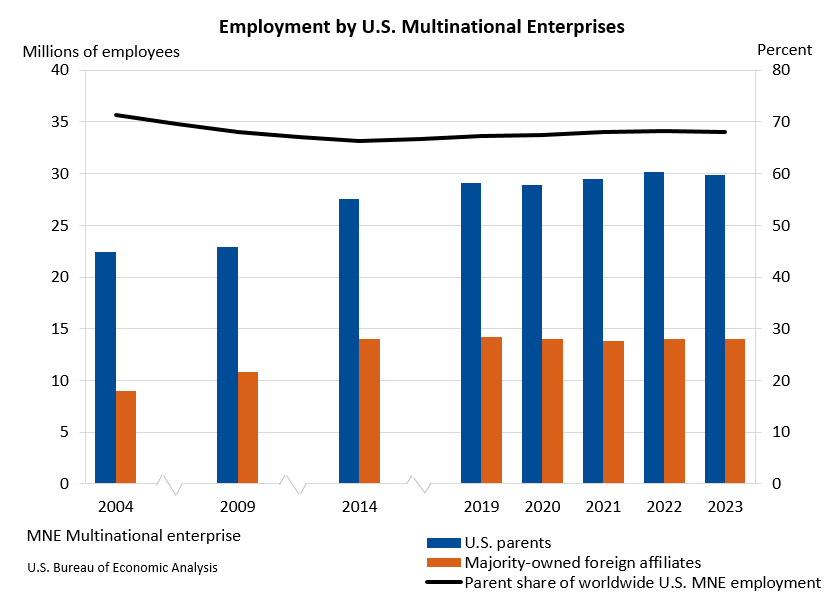Bureau of Economic Analysis
Activities of U.S. Multinational Enterprises, 2023
Worldwide employment by U.S. multinational enterprises decreased 0.4 percent to 43.9 million workers in 2023 (preliminary) from 44.1 million workers in 2022 (revised), according to statistics released today by the U.S. Bureau of Economic Analysis on the operations and finances of U.S. parent companies and their foreign affiliates.
Principal Federal Economic Indicators
Noteworthy
- 2025 News Release Schedule
- Innovation at BEA
- 2025 Annual Updates
- Distribution of Personal Income Nowcast
- New! Services Trade Data for More Countries
- Data Tool: Trade in Value Added
- Updated: RIMS II Regional Multipliers
- Arts and Culture
- Space Economy
- FDI Now in State BEARFACTS
- Quick Guide: Price Indexes
The Latest
U.S. Current-Account Deficit Narrows in Fourth Quarter 2021
The U.S. current-account deficit, which reflects the combined balances on trade in goods and services and income flows between U.S. residents and residents of other countries, narrowed by $2.0 billion, or 0.9 percent, to $217.9 billion in the fourth quarter of 2021. The narrowing reflected a reduced deficit on secondary income and expanded surpluses on services and on primary income that were mostly offset by an expanded deficit on goods. The…
U.S. International Transactions, Fourth Quarter and Year 2021
The U.S. current-account deficit narrowed by $2.0 billion, or 0.9 percent, to $217.9 billion in the fourth quarter of 2021, according to statistics released by the U.S. Bureau of Economic Analysis. The revised third-quarter deficit was $219.9 billion. The fourth-quarter deficit was 3.6 percent of current-dollar gross domestic product, down from 3.8 percent in the third quarter.
Personal Income by State, 2021 (Preliminary)
State personal income increased 7.4 percent in 2021 after increasing 6.6 percent in 2020. In 2021, increases in earnings, transfer receipts, and property income (dividends, interest, and rent) contributed to personal income growth in all states and the District of Columbia. The percent change in personal income across all states ranged from 9.6 percent in Idaho to 4.5 percent in Vermont.
Personal Income by State, 2021 (Preliminary) and 4th Quarter 2021
State personal income increased 7.4 percent in 2021 after increasing 6.6 percent in 2020. In 2021, increases in earnings, transfer receipts, and property income (dividends, interest, and rent) contributed to personal income growth in all states and the District of Columbia. The percent change in personal income across all states ranged from 9.6 percent in Idaho to 4.5 percent in Vermont.
Arts and Culture Economy Declines 6.4 Percent in 2020
Arts and cultural economic activity decreased an inflation-adjusted 6.4 percent in 2020, after increasing 3.4 percent in 2019, according to statistics released today by the U.S. Bureau of Economic Analysis.
Arts and cultural economic activity accounted for 4.2 percent of gross domestic product (GDP), or $876.7 billion, in 2020, the Arts and Cultural Production Satellite Account shows.
Arts and Cultural Production Satellite Account, U.S. and States, 2020
The Arts and Cultural Production Satellite Account released today by the U.S. Bureau of Economic Analysis (BEA) shows that arts and cultural economic activity, adjusted for inflation, decreased 6.4 percent in 2020 after increasing 3.4 percent in 2019. Arts and cultural economic activity accounted for 4.2 percent of gross domestic product (GDP), or $876.7 billion, in 2020.
2021 Trade Gap is $861.4 Billion
The U.S. international trade deficit increased in 2021 according to the U.S. Bureau of Economic Analysis and the U.S. Census Bureau. The deficit increased from $676.7 billion in 2020 to $861.4 billion in 2021, as imports increased more than exports. The goods deficit increased $169.4 billion in 2021 to $1,091.4 billion. The services surplus decreased $15.3 billion in 2021 to $230.0 billion. The goods and services deficit was 3.7 percent of…
January 2022 Trade Gap is $89.7 Billion
The U.S. monthly international trade deficit increased in January 2022 according to the U.S. Bureau of Economic Analysis and the U.S. Census Bureau. The deficit increased from $82.0 billion in December (revised) to $89.7 billion in January, as imports increased and exports decreased. The previously published December deficit was $80.7 billion. The goods deficit increased $7.1 billion in January to $108.9 billion. The services surplus…
U.S. International Trade in Goods and Services, January 2022
The U.S. monthly international trade deficit increased in January 2022 according to the U.S. Bureau of Economic Analysis and the U.S. Census Bureau. The deficit increased from $82.0 billion in December (revised) to $89.7 billion in January, as imports increased and exports decreased. The previously published December deficit was $80.7 billion. The goods deficit increased $7.1 billion in January to $108.9 billion. The services surplus decreased $…
Gross Domestic Product for the U.S. Virgin Islands, 2020
Real gross domestic product (GDP) for the U.S. Virgin Islands (USVI) decreased 2.2 percent in 2020 after increasing 2.8 percent in 2019. The decrease in real GDP reflected decreases in exports of services, private fixed investment, personal consumption expenditures, and government spending. These decreases were partly offset by an increase in private inventory investment.




